Whirlpool GU2400, GU2548, GU2500, DU1145, DUL240 User Manual
...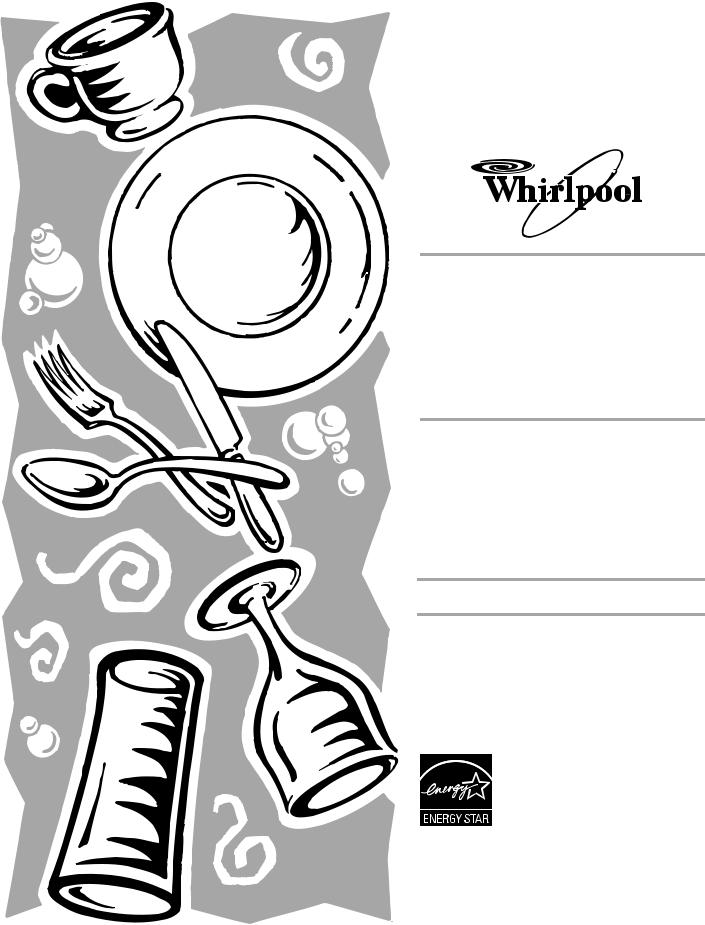
®
DISHWASHER
Use&CareGuide
For questions about features, operation/performance parts, accessories or service, call: 1-800-253-1301.
In Canada, call for assistance 1-800-461-5681, for installation and service, call: 1-800-807-6777
or visit our website at...
www.whirlpool.com or www.whirlpoolappliances.ca
LAVE-VAISSELLE
Guided’utilisation etd’entretien
Au Canada, pour assistance, composez le 1-800-461-5681, pour installation ou service, le 1-800-807-6777
ou visitez notre site web à www.whirlpoolappliances.ca
Table of Contents/Table des matières................ |
2 |
Models/Modèles
DU1050, DU1100, DU1101, DU1145, DU1148, DUC600, DUL240, GU2400, GU2500, GU2548, GU2600, GU3200
8535541

TABLE OF CONTENTS |
|
DISHWASHER SAFETY ................................................................. |
3 |
Before Using Your Dishwasher.................................................... |
4 |
PARTS AND FEATURES................................................................ |
5 |
Control Panels.............................................................................. |
6 |
START-UP GUIDE .......................................................................... |
7 |
Using Your New Dishwasher ....................................................... |
7 |
Stopping Your Dishwasher .......................................................... |
8 |
DISHWASHER LOADING.............................................................. |
8 |
Loading Suggestions ................................................................... |
8 |
Loading Top Rack........................................................................ |
8 |
Loading Bottom Rack ................................................................ |
10 |
Loading Silverware Basket ........................................................ |
11 |
DISHWASHER USE ...................................................................... |
13 |
Detergent Dispenser .................................................................. |
13 |
Rinse Aid Dispenser ................................................................... |
14 |
Dishwasher Efficiency Tips ........................................................ |
14 |
Cycle Selection Charts............................................................... |
15 |
Canceling a Cycle ...................................................................... |
16 |
Changing a Cycle or Setting ...................................................... |
16 |
Adding Items During a Cycle ..................................................... |
16 |
Option Selections....................................................................... |
16 |
Cycle Status Indicators.............................................................. |
18 |
Active Vent (on some models) ................................................... |
18 |
Drying System ............................................................................ |
18 |
Overfill Protection Float.............................................................. |
18 |
WASHING SPECIAL ITEMS......................................................... |
19 |
DISHWASHER CARE ................................................................... |
20 |
Cleaning...................................................................................... |
20 |
Drain Air Gap.............................................................................. |
20 |
Storing ........................................................................................ |
20 |
TROUBLESHOOTING .................................................................. |
21 |
WASH MODULE ........................................................................... |
23 |
ASSISTANCE OR SERVICE......................................................... |
23 |
In the U.S.A. ............................................................................... |
23 |
In Canada ................................................................................... |
23 |
WARRANTY .................................................................................. |
24 |
TABLE DES MATIÈRES |
|
LA SÉCURITÉ DU LAVE-VAISSELLE ......................................... |
25 |
Avant d’utiliser le lave-vaisselle ................................................. |
26 |
PIÈCES ET CARACTÉRISTIQUES .............................................. |
27 |
Tableaux de commande ............................................................ |
28 |
GUIDE DE MISE EN MARCHE .................................................... |
29 |
Utilisation de votre nouveau lave-vaisselle................................ |
29 |
Arrêt du lave-vaisselle ................................................................ |
30 |
CHARGEMENT DU LAVE-VAISSELLE ....................................... |
30 |
Suggestions de chargement ...................................................... |
30 |
Chargement du panier supérieur ............................................... |
30 |
Chargement du panier inférieur ................................................. |
32 |
Chargement du panier à couverts ............................................. |
33 |
UTILISATION DU LAVE-VAISSELLE........................................... |
35 |
Distributeur de détergent ........................................................... |
35 |
Distributeur d'agent de rinçage.................................................. |
36 |
Conseils d’efficacité pour le lave-vaisselle ................................ |
36 |
Tableaux de sélection de programmes ..................................... |
37 |
Annulation d’un programme ...................................................... |
38 |
Changement d’un programme ou réglage ................................ |
38 |
Addition de vaisselle durant un programme.............................. |
39 |
Sélection d’options..................................................................... |
39 |
Indicateurs d’état d’avancement du programme ...................... |
41 |
Évent actif (sur certains modèles) .............................................. |
41 |
Système de séchage.................................................................. |
41 |
Dispositif de protection contre le débordement........................ |
41 |
LAVAGE D’ARTICLES SPÉCIAUX .............................................. |
42 |
ENTRETIEN DU LAVE-VAISSELLE............................................. |
43 |
Nettoyage ................................................................................... |
43 |
Dispositif anti-refoulement ......................................................... |
43 |
Remisage.................................................................................... |
43 |
DÉPANNAGE................................................................................. |
44 |
MODULE DE LAVAGE.................................................................. |
46 |
ASSISTANCE OU SERVICE......................................................... |
46 |
Aux États-Unis............................................................................ |
46 |
Au Canada.................................................................................. |
46 |
GARANTIE..................................................................................... |
47 |
®
2
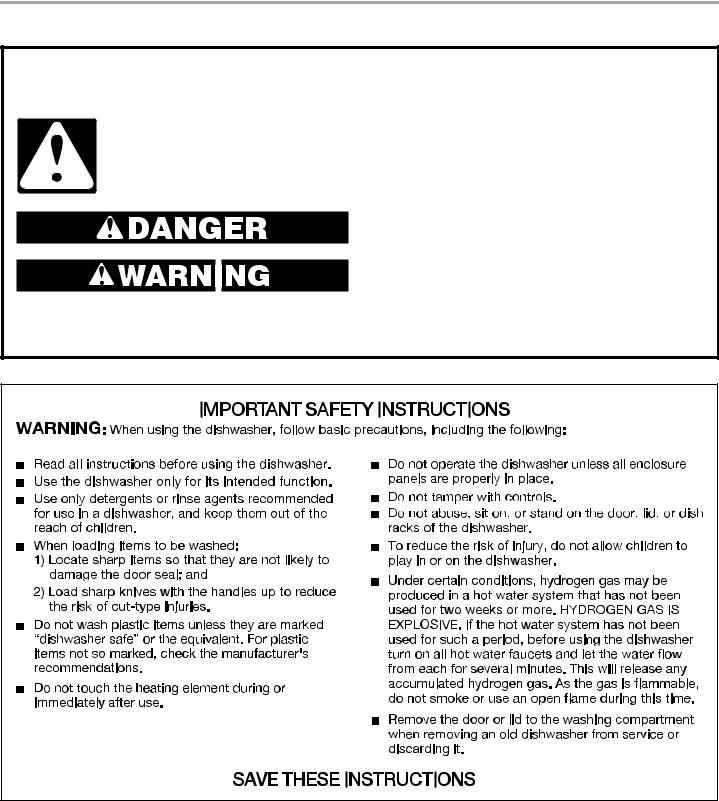
DISHWASHER SAFETY
Your safety and the safety of others are very important.
We have provided many important safety messages in this manual and on your appliance. Always read and obey all safety messages.
This is the safety alert symbol.
This symbol alerts you to potential hazards that can kill or hurt you and others.
All safety messages will follow the safety alert symbol and either the word “DANGER” or “WARNING.” These words mean:
You can be killed or seriously injured if you don't immediately follow instructions.
You can be killed or seriously injured if you don't follow instructions.
All safety messages will tell you what the potential hazard is, tell you how to reduce the chance of injury, and tell you what can happen if the instructions are not followed.
3

BeforeUsingYourDishwasher
Tip Over Hazard
Do not use dishwasher until completely installed.
Do not push down on open door.
Doing so can result in serious injury or cuts.
Electrical Shock Hazard
Electrically ground dishwasher.
Connect ground wire to green ground connector in terminal box.
Do not use an extension cord.
Failure to follow these instructions can result in death, fire, or electrical shock.
■Install where dishwasher is protected from the elements. Protect against freezing to avoid possible rupture of fill valve. Such ruptures are not covered by the warranty. See “Storing” in the “Dishwasher Care” section for winter storage information.
■Install and level dishwasher on a floor that will hold the weight, and in an area suitable for its size and use.
■Remove all shipping plugs from hoses and connectors (such as the cap on the drain outlet) before installing. See Installation Instructions for complete information.
4
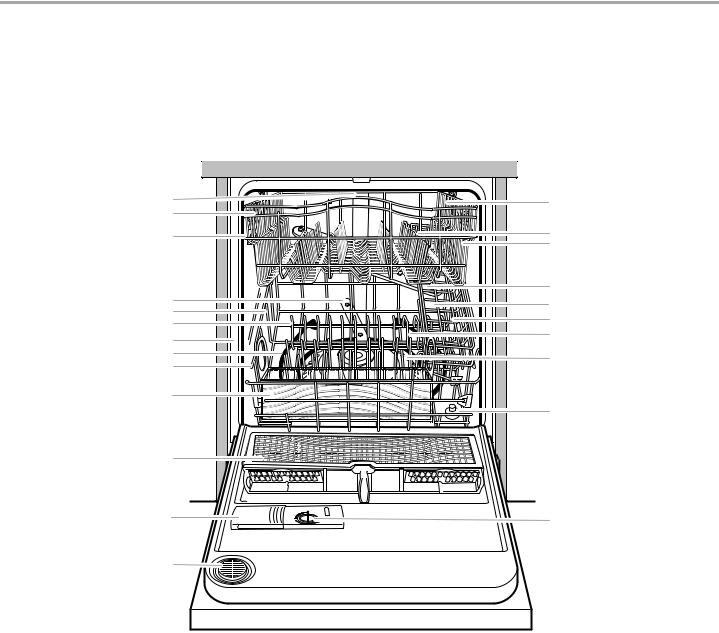
PARTS AND FEATURES
This manual covers several different models. The dishwasher you have purchased may have some or all of the parts and features listed below.
A |
N |
|
B |
||
|
||
C |
O |
|
P |
||
|
||
D |
Q |
|
R |
||
E |
||
S |
||
F |
||
T |
||
G |
||
|
||
H |
U |
|
I |
||
|
||
J |
|
|
|
V |
|
K |
|
|
L |
W |
|
|
||
M |
|
A.Upper level wash
B.Two position adjusters (on some models)
C.Top rack
D.Lower spray arm
E.Bottom rack
F. Fold-down tines (on some models)
G.Model and serial number label
H.Heating element
I.Water inlet opening (in tub wall)
J.Silverware basket (on some models)
K. ANYWARE™ PLUS silverware basket (on some models)
L.Detergent dispenser
M.Vent
N.EZ-2-LIFT™ rack adjusters (on some models)
O.Fold-down tines (on some models) P. Cup shelves (on some models)
Q.Top spray arm
R. Utensil caddy (on some models)
S. Utensil rack (on some models)
T.FLIP AWAY™ plate holders (on some models)
U. Filter module
V.Overfill protection float
W.Rinse aid dispenser
Other features your dishwasher may have
Light item clips
5
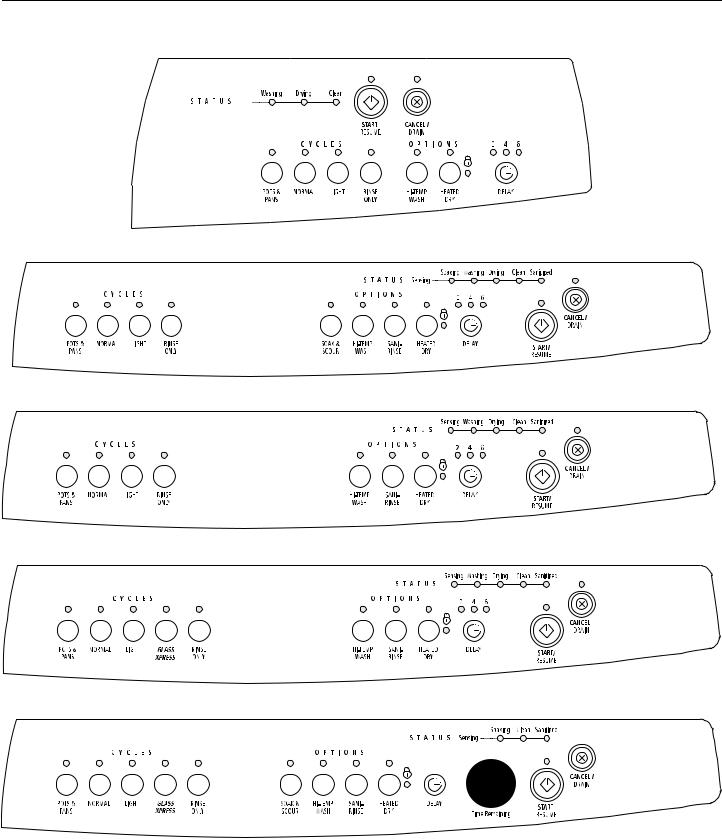
ControlPanels
DU1050, DUC600
DU1100, DU1101, DUL240
DU1145
DU1148
GU2400, GU3200
6
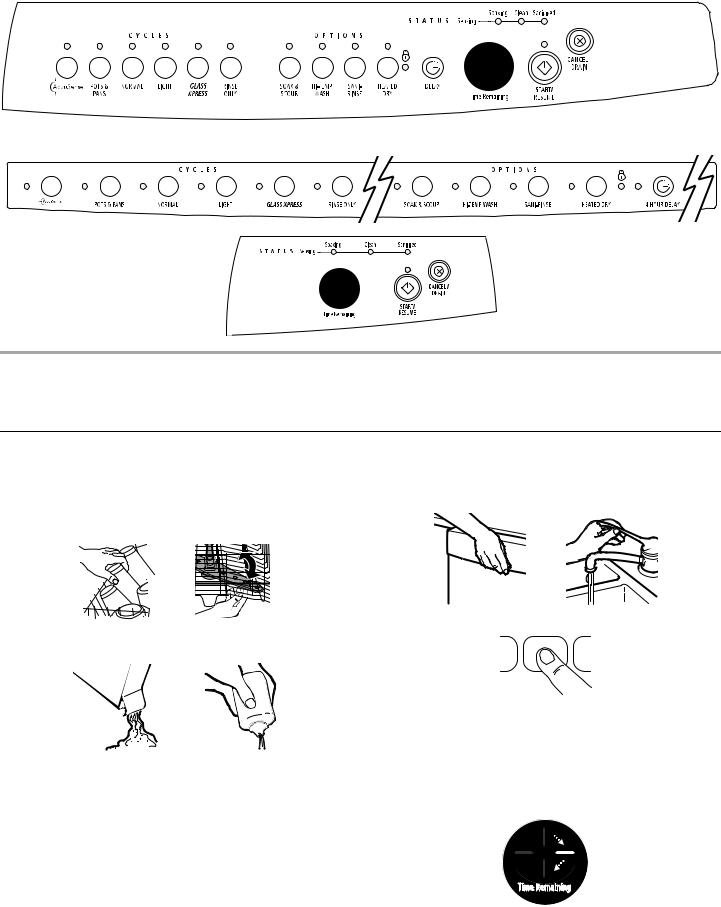
GU2500, GU2548
GU2600
START-UP GUIDE
Before using your dishwasher, remove all packaging materials. Read this entire Use and Care Guide. You will find important safety information and useful operating tips.
UsingYourNewDishwasher
1.Scrape large food soil and hard items (toothpicks or bones) from dishes.
2.Properly load the dishwasher. (See “Dishwasher Loading.”) Make sure nothing prevents the spray arm(s) from spinning freely.
3.Add detergent and check the rinse aid dispenser. Add rinse aid if needed. (See “Dishwasher Use.”)
4.Push door firmly closed. The door latches automatically. Run hot water at the sink nearest your dishwasher until the water is hot. (See “Dishwasher Efficiency Tips.”) Turn off water.
5.Press the desired cycle and option selections.
6.Press START/RESUME.
NOTE: If the door is opened during a cycle or the power is interrupted, the Start/Resume indicator flashes. The cycle will not resume until the door is closed, and Start/Resume is pressed.
IMPORTANT (on some models):
■When the cycle starts, you will see a rotating pattern of lights in the display window indicating that the unit is operating.
7
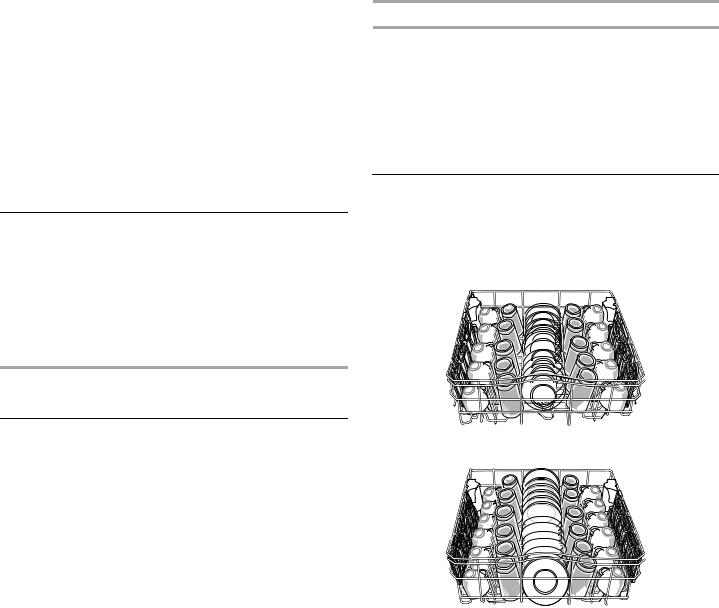
■This pattern will continue for up to 6 minutes while the multiple sensors check the incoming water temperature and soil level on dishes and cookware. The sensors then determine the ideal cycle for your dish load. After sensing is complete, the display will show the number of minutes left in the cycle and the cycle countdown will begin.
With the ACCUSENSE™ cycle (on some models), the pattern occurs again in the Main Wash while sensors determine the load size.
■The cycle countdown pauses and the sensing light glows while the dishwasher heats the water to a set temperature. (See “Cycle Selection Charts.”)
The time displayed does not include the time needed to heat the water.
StoppingYourDishwasher
You can stop your dishwasher anytime during a cycle.
1.Open the door slightly.
2.Wait for the spraying action to stop. Then open the door all the way, if needed.
Close the door and press START/RESUME to continue the cycle.
OR
Press CANCEL/DRAIN. A 2-minute drain starts.
DISHWASHER LOADING
LoadingSuggestions
■Remove leftover food, bones, toothpicks and other hard items from the dishes. It is not necessary to rinse the dishes before putting them into the dishwasher. The wash module removes food particles from the water. The module contains a chopping device which will reduce the size of food items.
NOTE: If hard items such as fruit seeds, nuts, and eggshells enter the wash module, you might hear chopping, grinding, crunching, or buzzing sounds. These sounds are normal when hard items enter the module. Do not let metallic items (such as pot handle screws) get into the wash module. Damage can occur.
■It is important for the water spray to reach all soiled surfaces.
■Load dishes so they are not stacked or overlapping, if possible. For best drying, water must be able to drain from all surfaces.
■Make sure pot lids and handles, pizza pans, cookie sheets, etc., do not interfere with the spray arm rotation.
■Run a rinse cycle to keep dishes moist if you do not plan to wash them soon. Foods such as eggs, rice, pasta, spinach, and cooked cereals may be hard to remove if they are left to dry over a period of time.
Quiet operating tips
To avoid thumping/clattering noises during operation:
■Make sure lightweight load items are secured in the racks.
■Make sure pot lids and handles, pizza pans, cookie sheets, etc., do not touch interior walls or interfere with the rotation of the spray arm.
■Load dishes so they do not touch one another.
NOTE: For built-in models, keep sink drain plugs closed during dishwasher operation to prevent noise transfer through drains.
LoadingTopRack
The top rack is designed for cups, glasses, and smaller items. Many items, up to 9" (22 cm), fit in the top rack. (See recommended loading patterns shown.)
NOTE: The features on your dishwasher rack may vary from the drawings shown.
10 place setting
12 place setting
■Place items so open ends face down for cleaning and draining.
■Load glasses in top rack only. The bottom rack is not designed for glasses. Damage can occur.
■Place cups and glasses in the rows between tines. Placing them over the tines can lead to breakage and water spots.
■China, crystal, and other delicate items must not touch each other during dishwasher operation. Damage may occur.
■Load lightweight plastic items in the top rack only. Only plastic items marked “dishwasher safe” are recommended.
8
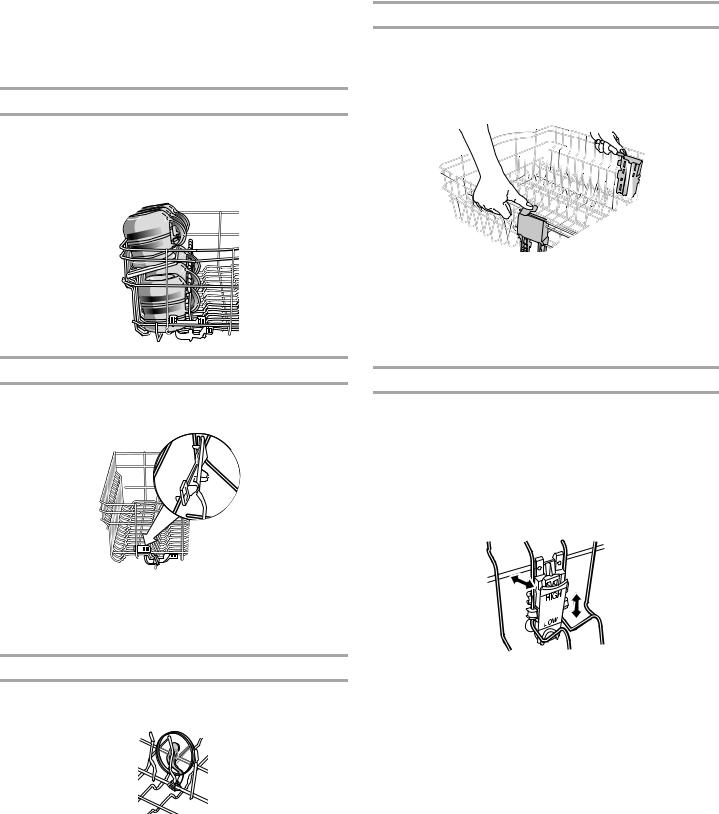
■Load plastic items so the force of the spray does not move them during the cycle.
■To avoid chipping, do not let stemware touch other items.
■Small bowls, pans, and other utensils can be placed in the top rack. Load bowls in the center section for best stability.
Cup shelves (on some models)
Fold down the extra shelf on the left-hand or right-hand side of the top rack to hold additional cups, stemware or long items such as utensils and spatulas.
NOTE: The features on your dishwasher may vary from those shown below.
Fold-down tines (on some models)
The row of tines on the left-hand and right-hand sides of the top rack can be folded down to make room for a variety of dishes.
To adjust the fold-down tines
1.Grasp the tip of the tine that is in the tine holder.
2.Gently push the tine out of the holder.
3.Lay the tines down, toward the center of the rack.
Light item clips (on some models)
The light item clips hold lightweight plastic items such as cups, lids, or bowls in place during washing.
To move a clip
1.Pull the clip up and off the tine.
2.Reposition the clip on another tine.
EZ-2-Lift™ top rack (on some models)
You can raise or lower the top rack to fit tall items in either the top or bottom rack. Raise the top rack to accommodate items up to 9" (22 cm) in the top rack and 13" (33 cm) in the bottom rack, or lower the top rack to accommodate items up to 11" (28 cm) in both the top and bottom racks. Adjusters are located on each side of the top rack.
To raise the top rack
Lift the rack on both sides until the rack is level.
NOTE: The top rack must be level.
To lower the top rack
Depress both tabs on rack adjusters, as shown above, and slide the rack back to its original position.
Adjustable 2-position top rack (on some models)
You can raise or lower the top rack to fit tall items in either the top or bottom rack. Raise the top rack to accommodate items up to 9" (22 cm) in the top rack and 13" (33 cm) in the bottom rack, or lower the top rack to accommodate items up to 11" (28 cm) in both the top and bottom racks. Two adjusters are located on each side of the top rack. Each adjuster has 2 preset positions. The high and low positions are marked on the adjuster.
To adjust the top rack
1. Hold the top rack with one hand near the adjuster.
2.With the other hand, pull out the top of the adjuster.
3.Raise or lower the rack to one of the preset positions.
4.Release the adjuster.
5.Repeat the steps for the remaining adjusters.
NOTE: The top rack must be level.
9
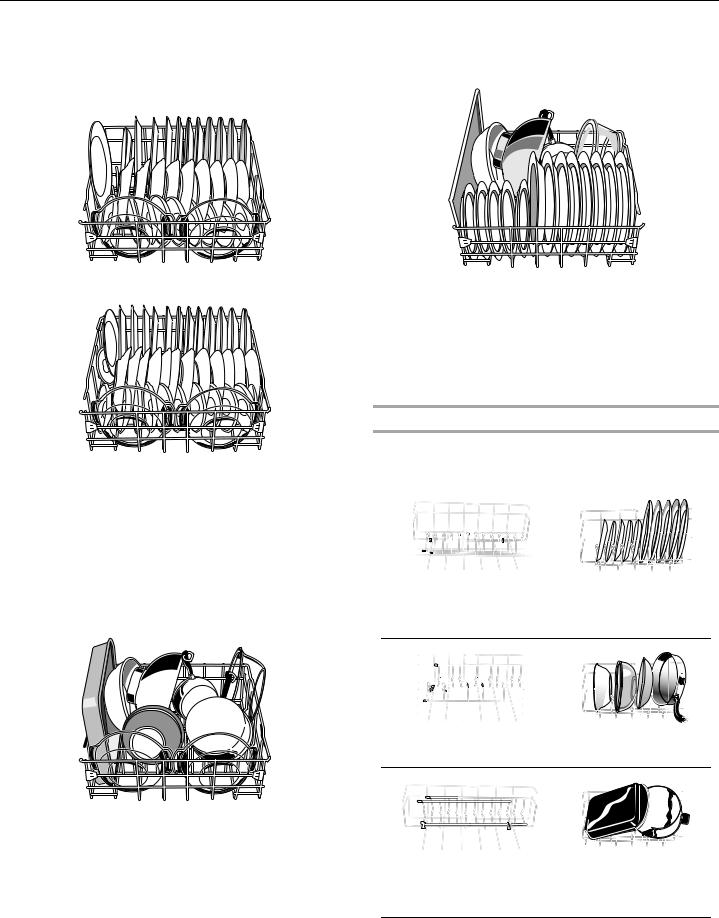
LoadingBottomRack
The bottom rack is designed for plates, pans, casseroles, and utensils. Many items, up to 13" (33 cm) tall, fit in the bottom rack. (See recommended loading patterns shown.)
NOTE: The features on your dishwasher rack may vary from the drawings shown.
■Load cookie sheets, cake pans, and other large items at the sides and back. Loading such items in front can keep the water spray from reaching the detergent dispenser.
10 place setting
12 place setting
■Do not load glasses, cups, or plastic items in the bottom rack. Load small items in the bottom rack only if they are secured in place.
■Load plates, soup bowls, etc., between tines.
■Overlap the edges of plates for large loads.
■Load soup, cereal, and serving bowls in the rack in a variety of ways depending upon their size and shape. Load bowls securely between the rows of tines. Do not nest bowls because the spray will not reach all surfaces.
Utensil load
Mixed load
■Secure heavily soiled cookware face down in the rack.
■Make sure pot handles and other items do not stop rotation of the spray arm(s). The spray arm(s) must move freely.
■Do not load items between the bottom rack and the side of the dishwasher tub because they might block the water inlet opening.
FLIP AWAY™ plate holders (on some models)
You can fold up all, or part, of the row of V-shaped flexible tines at the back of the bottom rack. This is useful when washing a variety of dishes, pots and pans, or roasters.
Place the entire row of tines in the down position when washing a large number of plates.
Fold away the plate tines to hold many bowls.
Fold away the entire row of both plate and bowl tines to make room for larger pans or roasters.
10
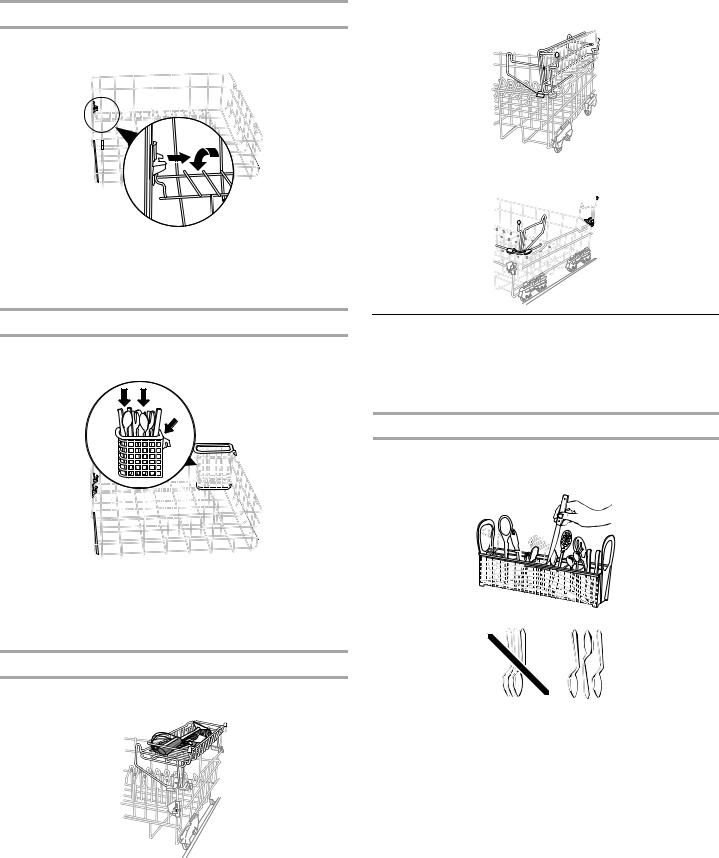
Fold-down tines (on some models)
You can fold down one row of tines at the back of the bottom rack.
1.Grasp the tip of the tine that is in the tine holder.
2.Gently pull the tine out of the tine holder.
3.Lay the row of tines down in the rack to make room for larger dishes, bowls, pots, pans or roasters.
Utensil caddy (on some models)
Use the utensil caddy to hold wooden spoons, spatulas, and similar items.
The utensil caddy has three hooks. (See arrows.) For best wash performance, hook the utensil caddy in the right rear corner of the lower rack. You can also hook it in the left front corner.
NOTE: Spin the top spray arm. Be sure items in the utensil caddy do not stop the rotation of the spray arm.
Utensil rack (on some models)
Use the utensil rack to hold specialty cooking items (wooden spoons, spatulas, and similar items).
The utensil rack lies on the two supports in the right-hand lower rack. Load the rack tray while it is in the dishwasher or remove it for loading on a counter or table top.
When not in use, the utensil rack may remain in the dishwasher and tilt out of the way.
You can also remove the utensil rack from the dishwasher. Swing the two supports out of the way for easier bottom rack loading.
LoadingSilverwareBasket
Load the silverware basket while it is in the dishwasher or take the basket out for loading on a counter or table top.
NOTE: Unload or remove the basket before unloading the racks to avoid spilling water droplets onto the silverware.
Style 1 (on some models)
Mix items in each section of the basket with some pointing up and some down to avoid nesting. Spray cannot reach nested items.
IMPORTANT: Always load items (knives, skewers, etc.) pointing down.
NOTES:
■Do not load silver or silver-plated silverware with stainless steel. These metals can be damaged by contact with each other during washing.
■Some foods (such as salt, vinegar, milk products, fruit juices, etc.) can pit or corrode silverware. Run a rinse cycle if you do not have a full load to wash immediately.
11
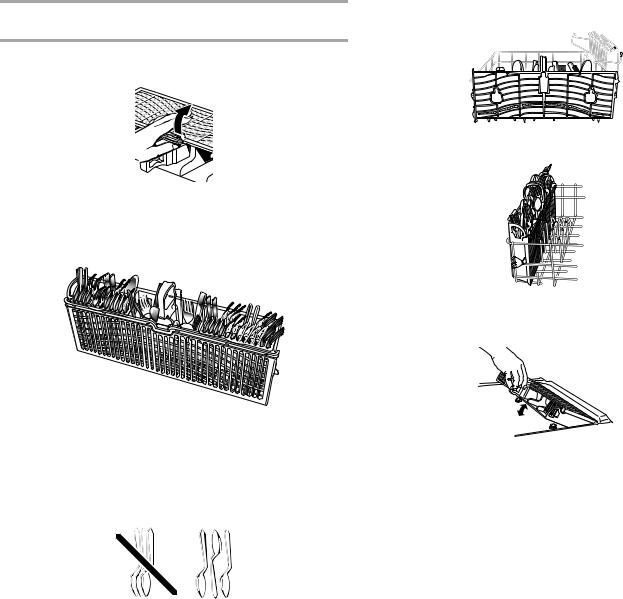
Style 2 (on some models)
ANYWARE™ PLUS silverware basket
To open the silverware basket
Unlock the latch.
NOTE: Be sure the cover is completely latched before pulling out the bottom rack and before closing the dishwasher door.
■Place small items such as baby bottle caps, jar lids, corncob holders, etc., in the section(s) with hinged cover(s). Close the cover to hold small items in place.
■The silverware basket can be hung on the door or on the bottom rack (see illustration).
■The silverware basket can also be placed inside the bottom rack.
■Use suggested loading patterns as shown to increase the washability of your silverware, if your silverware basket has these covers.
■If your silverware basket does not have covers, or when covers are up, mix items in each section of the basket with some pointing up and some down to avoid nesting. Spray cannot reach nested items.
IMPORTANT: Always load items (knives, skewers, etc.) pointing down.
To remove the basket from the door
1.Grasp the silverware basket by the handle. Slide it toward the top of the door.
2. Lift the basket off the holding buttons.
To replace the basket in the door
1.Set the silverware basket on the holding buttons.
2.Slide the basket toward the bottom of the door until it locks into place.
NOTES:
■Do not load silver or silver-plated silverware with stainless steel. These metals can be damaged by contact with each other during washing.
■Some foods (such as salt, vinegar, milk products, fruit juices, etc.) can pit or corrode silverware. Run a rinse cycle if you do not have a full load to wash immediately.
12

DISHWASHER USE
DetergentDispenser
The detergent dispenser has two sections. The smaller Pre-Wash section empties detergent into the dishwasher when you close the door. The larger Main Wash section automatically empties detergent into the dishwasher during the wash. (See the “Cycle Selection Charts.”)
A 
Hard Water |
Hard Water |
|
Soft Water |
||
Soft Water |
||
|
B
 C
C
PRE-
MAIN WASH WASH
A.Cover latch
B.Main Wash section
C.Pre-Wash section
■Use automatic dishwashing detergent only. Other detergents can produce excessive suds that can overflow out of the dishwasher and reduce washing performance.
■Add detergent just before starting cycle.
■Store tightly closed detergent in a cool, dry place. Fresh automatic dishwasher detergent results in better cleaning.
NOTE: Do not use detergent with a rinse cycle.
Filling the dispenser
1.If the dispenser cover is closed, open the cover by moving the cover latch to the right.
Hard Water |
Hard Water |
|
Soft Water |
||
Soft Water |
||
|
||
|
PRE- |
|
MAIN WASH |
WASH |
2.Add the correct amount of detergent to the Main Wash section of the dispenser according to the chart below. If you are using a tablet detergent, it must be placed in the Main Wash section. (See “How much detergent to use.”)
3.Add the correct amount of detergent to the Pre-Wash section of the dispenser, if needed, according to the chart below.
4.Close the dispenser cover.
It is normal for the cover to open partially when dispensing detergent.
NOTE: See the “Cycle Selection Charts” for which section to fill depending on the cycle selected.
How much detergent to use
■The amount of detergent to use depends on the soil level of your dishes, hardness of your water, and the type of detergent. If you use too little, dishes will not be clean. If you use too much in soft water, glassware will etch.
■Water hardness can change over a period of time. Find out your water’s hardness by asking your local water department, water softener company, or county extension agent.
Detergent Dispenser fill recommendations per dish load soil level and water hardness
Water Hardness |
Light Soil or Prerinsed |
Normal - Heavy Soil |
|||
|
|
|
|
||
Main Wash section |
Pre-Wash section |
Main Wash section |
Pre-Wash section |
||
|
|||||
|
|
|
|
|
|
Soft |
4 tsp (20 mL) |
Empty |
6 tsp (30 mL) |
2 tsp (10 mL) |
|
(0-2 grains per |
Fill to Soft Water line |
|
Fill above the Soft Water line |
Fill to Soft Water line |
|
U.S. gallon) |
|
|
|
|
|
|
|
|
|
|
|
Medium |
6 tsp (30 mL) |
2 tsp (10 mL) |
6 tsp (30 mL) |
4 tsp (20 mL) |
|
(2-6 grains per |
Fill above the Soft Water line |
Fill to Soft Water line |
Fill above the Soft Water line |
Fill to Hard Water line |
|
U.S. gallon) |
|
|
|
|
|
|
|
|
|
|
|
Hard |
8 tsp (40 mL) |
4 tsp (20 mL) |
9 tsp (45 mL) |
7 tsp (35 mL) |
|
(7 grains per U.S. gallon |
Fill to Hard Water line |
Fill to Hard Water line |
Fill cup completely |
Fill cup completely |
|
and above) |
|
|
|
|
|
|
|
|
|
|
|
NOTE: Fill amounts shown are for standard powdered detergent. Amounts may vary if you use liquid or concentrated powdered detergent. Tablet detergents should be placed in the main wash section of the detergent dispenser with the cover closed. Follow instructions on the package when using liquid dishwasher detergent, concentrated powdered detergent or tablet detergent.
13
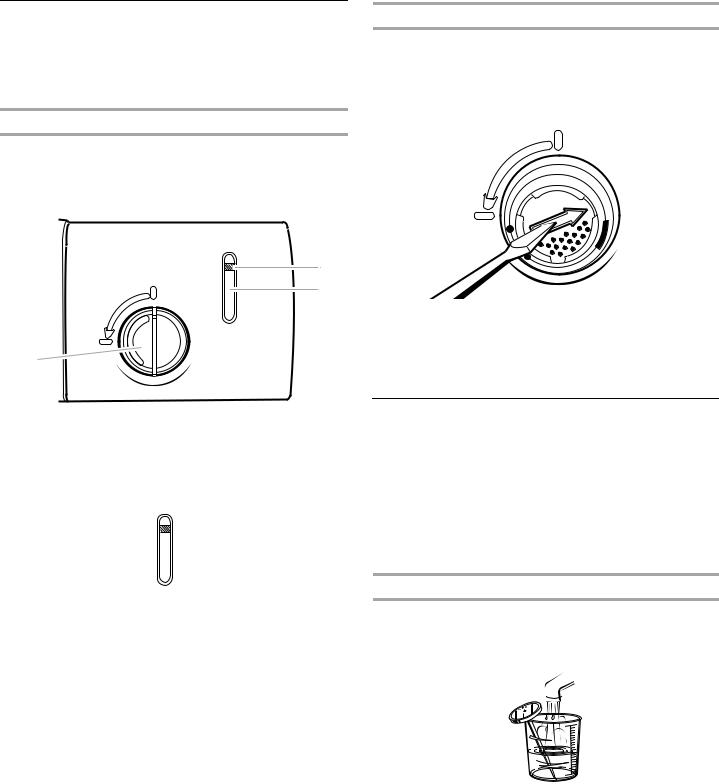
RinseAidDispenser
IMPORTANT: Your dishwasher is designed to use a liquid rinse aid. The use of rinse aids greatly improves drying by allowing water to drain from the dishes after the final rinse. They also prevent water from forming droplets that can dry as spots or streaks. Do not use a solid or bar-type rinse aid.
Filling the dispenser
The rinse aid dispenser holds 5 oz (150 mL) of rinse aid. Under normal conditions, this will last for about 1 to 3 months.
1.Make sure the dishwasher door is fully open.
2.Turn the dispenser knob to “Open” and lift it out.
USE RINSE AID FOR
BETTER DRYING |
Full |
B |
|
Lock |
C |
|
|
|
Add |
Open |
|
A
A.Dispenser knob
B.Indicator
C.Indicator window
3.Pour rinse aid into the opening until the indicator points to “Full.” Take care not to overfill. (When the rinse aid indicator drops to the “Add” level, add more rinse aid.)
Full
Add
4.Clean up any spilled rinse aid with a damp cloth.
5.Place the knob back into the opening and turn to the “Lock” position.
Rinse aid setting
The amount of rinse aid released into the final rinse can be adjusted. For most water conditions, the factory setting of 2 will give good results. If you have hard water or notice rings or calcium spots on your glasses or dishes, try a higher setting.
Lock
- |
6 |
5 |
4 |
fill |
|
|
|
|
|
3 |
Open |
max |
|
|
|
1 |
|
|
|
|
|
2 |
|
|
|
|
- |
- |
|
|
|
- |
|
|
|
|
- |
|
|
|
|
|
|
|
|
To adjust the setting
1.Remove the dispenser knob.
2.Turn the arrow adjuster inside the dispenser to the desired setting by either using your fingers or inserting a flat-blade screwdriver into the center of the arrow and turning.
3.Replace the dispenser knob.
DishwasherEfficiencyTips
Hot water dissolves and activates the dishwashing detergent. Hot water also dissolves grease on dishes and helps glasses dry spot-free. For best dishwashing results, water should be 120°F (49°C) as it enters the dishwasher. Loads may not wash as well if the water temperature is too low. Water that is too hot can make some soils harder to remove and cause certain detergent ingredients not to function. If your water heater is located far from the dishwasher, it may be necessary to run the hot water at the faucet closest to the dishwasher to minimize the amount of cold water in the water line.
To check water temperature
1.Run hot water at the faucet closest to your dishwasher for at least 1 minute.
2.Place a candy or meat thermometer in a glass measuring cup.
3.Check the temperature on the thermometer as the water is running into the cup.
■To save water, energy and time, do not rinse dishes before putting them into the dishwasher.
14

■Use a low energy, quick, or short cycle whenever possible. These cycles use less hot water and energy than a normal cycle.
■Use a delay feature (on some models) to run your dishwasher during off-peak hours. Local utilities recommend avoiding heavy usage of energy at certain times of day.
■During the summer, run your dishwasher at night. This reduces daytime heat buildup in the kitchen.
■Use the energy-saving dry option whenever possible. Allow longer drying times (overnight) when using these options. Use a rinse aid to improve drying.
■Use cycles or options that add extra heat to the wash or rinse portion of the cycle only when needed.
■Run your dishwasher with full loads. Run a rinse cycle after meals until the dishwasher is full.
■If your home is equipped with a water softener, you may want to avoid starting the dishwasher during the regeneration of the softener, since this may contribute to poor wash performance.
CycleSelectionCharts
Select the wash cycle and options desired and press START/ RESUME. The dishwasher starts filling once you press START/ RESUME, unless you select a delay wash. You can change cycles and options as the machine is filling.
After completing a wash cycle, the dishwasher remembers the cycle and options. It uses the same cycle and options again in the next wash cycle, if you press only START/RESUME.
NOTE: If the door is opened during a cycle or the power is interrupted, the Start/Resume indicator flashes. The cycle will not resume until the door is closed and Start/Resume is pressed.
A “●” shows what steps are in each cycle. Your model may have some or all of the cycles shown.
Display time is for models with the dual digit display on the console.
These models meet the ENERGY STAR® guidelines for energy efficiency.
Temperatures indicate where extra heat is added. The cycle countdown (on some models) pauses at these points until water reaches the temperature.
Water usage is shown in U.S. gallons/liters.
ACCUSENSE™ cycle (on some models)
Use this cycle for all day-to-day soil types when washing full to partial dish loads. This cycle compensates for the size of the dish load by adding time and heat. During the wash, the wash action will repeatedly pause for several seconds.
Initial display time after rotating clock pattern: 79-87 min.
Use both detergent dispenser sections when washing a full soiled dish load.
Use one detergent dispenser section when washing lightly soiled, partial dish loads.
Pre- |
Main |
Purge |
Rinse |
Final |
Dry |
Mini- |
Water |
Wash |
Wash |
|
|
Heated |
|
mum |
Usage |
|
|
|
|
Rinse |
|
Time |
(gal/L) |
|
|
|
|
|
|
(min) |
|
● |
● |
● |
|
● |
● |
68* |
5.6-6.5/ |
|
120°F |
|
|
140°F |
|
Light |
21.2-24.6 |
|
(49°C) |
|
|
(60°C) |
|
soil |
|
Pots & Pans
Use this cycle for hard-to-clean, heavily soiled pots, pans, casseroles, and regular tableware. During the wash, the wash action will repeatedly pause for several seconds.
Initial display time after rotating clock pattern: 92-99 min.
Use both detergent dispenser sections.
Pre- |
Main |
Rinse |
Rinse |
Final |
Dry |
Mini- |
Water |
Wash |
Wash |
|
|
Heated |
|
mum |
Usage |
|
|
|
|
Rinse |
|
Time |
(gal/L) |
|
|
|
|
|
|
(min) |
|
● |
● |
● |
|
● |
● |
99* |
6.9-7.8/ |
|
140°F |
|
|
140°F |
|
Light |
26.1-29.6 |
|
(60°C) |
|
|
(60°C) |
|
soil |
|
Normal
Use this cycle for loads with normal amounts of food soil. (The energy-usage label is based on this cycle.) During the wash, the wash action will repeatedly pause for several seconds.
Initial display time after rotating clock pattern: 64-84 min.
Use both detergent dispenser sections.
Pre- |
Main |
Purge |
Rinse |
Final |
Dry |
Mini- |
Water |
Wash |
Wash |
|
|
Heated |
|
mum |
Usage |
|
|
|
|
Rinse |
|
Time |
(gal/L) |
|
|
|
|
|
|
(min) |
|
● |
● |
● |
|
● |
● |
71* |
5.6-6.8/ |
|
120°F |
|
|
140°F |
|
Light |
21.2-25.7 |
|
(49°C) |
|
|
(60°C) |
|
soil |
|
Light (on some models)
Use this cycle for lightly soiled items or china and crystal. During the wash, the wash action will repeatedly pause for several seconds.
Initial display time after rotating clock pattern: 68-81 min.
Use main detergent dispenser section.
Rinse |
Main |
Purge |
Rinse |
Final |
Dry |
Mini- |
Water |
|
Wash |
|
|
Heated |
|
mum |
Usage |
|
|
|
|
Rinse |
|
Time |
(gal/L) |
|
|
|
|
|
|
(min) |
|
● |
● |
● |
|
● |
● |
77* |
5.9-6.8/ |
|
120°F |
|
|
135°F |
cycled |
Light |
22.3-25.7 |
|
(49°C) |
|
|
(57°C) |
|
soil |
|
GLASS XPRESS™ cycle (on some models)
Use this cycle to quickly wash prerinsed glasses or dish loads. This cycle does not dry.
NOTE: Time and water use do not vary in this cycle. Initial display time after rotating clock pattern: 29 min.
Use main detergent dispenser section.
Pre- |
Main |
Rinse |
Rinse |
Final |
Dry |
Mini- |
Water |
Wash |
Wash |
|
|
Heated |
|
mum |
Usage |
|
|
|
|
Rinse |
|
Time |
(gal/L) |
|
|
|
|
|
|
(min) |
|
● |
● |
● |
|
● |
|
30 |
6.9/26.0 |
|
|
|
|
|
|
|
|
15
